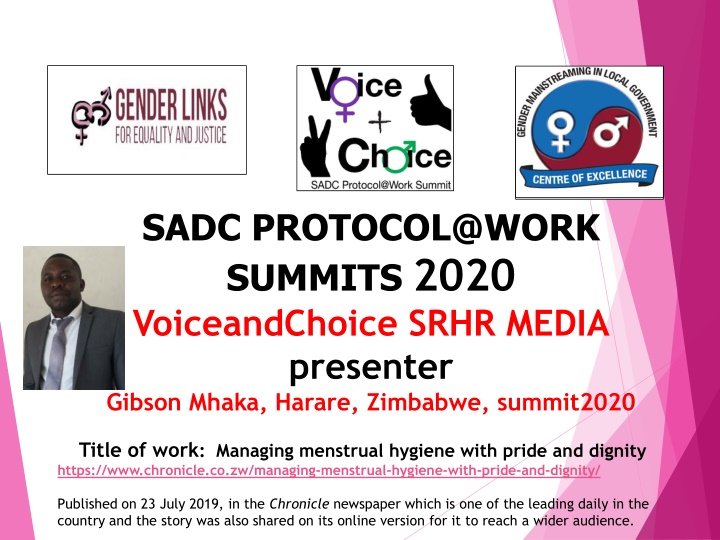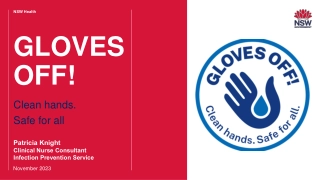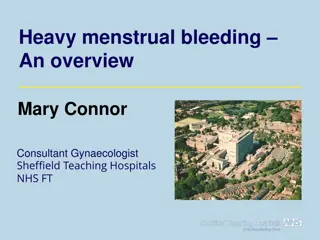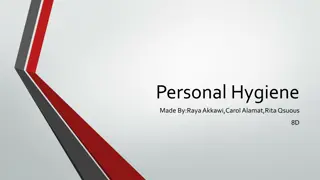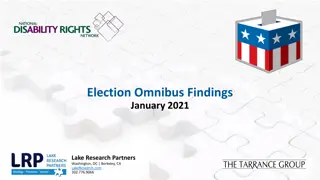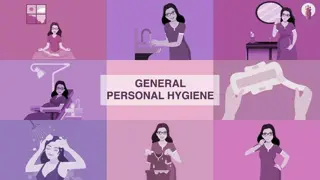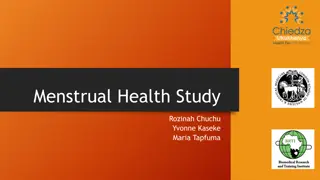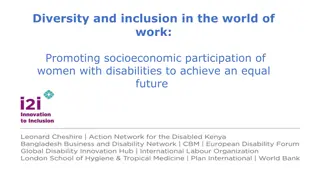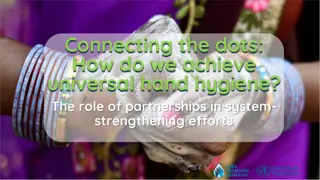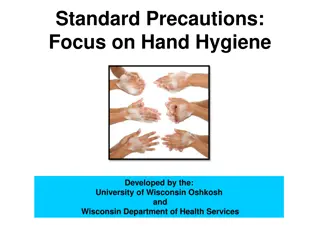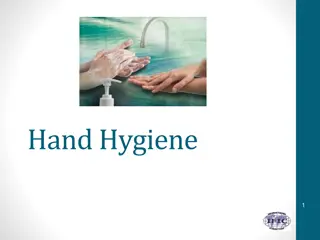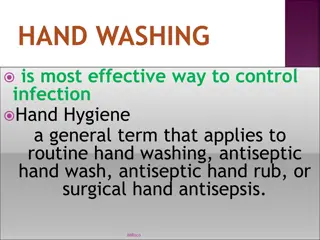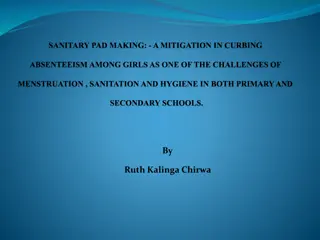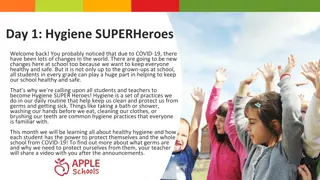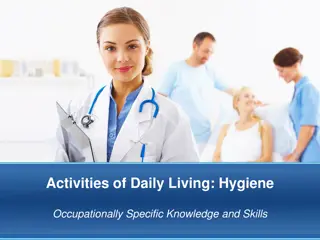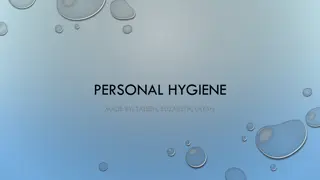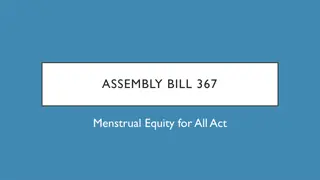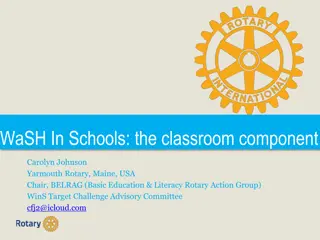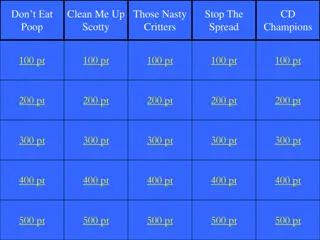Addressing Challenges in Menstrual Hygiene for Women with Disabilities
The story sheds light on the struggles of women and girls with disabilities in managing menstrual hygiene, emphasizing the lack of attention to this issue in regional and global initiatives. It aims to promote gender awareness and sensitivity by highlighting the double marginalization faced by these individuals and advocating for inclusive SRHR services.
Download Presentation

Please find below an Image/Link to download the presentation.
The content on the website is provided AS IS for your information and personal use only. It may not be sold, licensed, or shared on other websites without obtaining consent from the author.If you encounter any issues during the download, it is possible that the publisher has removed the file from their server.
You are allowed to download the files provided on this website for personal or commercial use, subject to the condition that they are used lawfully. All files are the property of their respective owners.
The content on the website is provided AS IS for your information and personal use only. It may not be sold, licensed, or shared on other websites without obtaining consent from the author.
E N D
Presentation Transcript
SADC PROTOCOL@WORK SUMMITS 2020 VoiceandChoice SRHR MEDIA presenter Gibson Mhaka, Harare, Zimbabwe, summit2020 Title of work: Managing menstrual hygiene with pride and dignity https://www.chronicle.co.zw/managing-menstrual-hygiene-with-pride-and-dignity/ Published on 23 July 2019, in the Chronicle newspaper which is one of the leading daily in the country and the story was also shared on its online version for it to reach a wider audience.
Dealing with menstrual hygiene is stressful and difficult for visually impaired women like me. Its even more difficult for young girls as they are always worried about how to deduce that their period has arrived or how to use products like pads correctly, said Winnet. Brief description of the item of work and motivation of why it is a good example of gender awareness and sensitivity in advancing gender equality. SYNOPSIS The story is about the challenges being encountered by women and girls with disabilities in managing their menstrual hygiene which sometimes leaves them at the risk of even more health problems. The story also highlights their struggle to attain SRHR and gender equality as they continue to face double marginalisation and discrimination due to the interface of gender and disability. It is a good example of gender awareness and sensitivity in advancing gender equality as at it highlights that misinformation surrounding menstruation hygiene is also contributing to shame, stigma and serious human rights concerns for girls and women with disabilities and their families. What & why makes the story relevant? What context does it respond to The story is relevant in the sense that unlike other stories to do with menstrual hygiene for women and adolescent girls this one exclusively unravels the challenges being encountered by women and girls with disabilities in managing their menstrual hygiene. It also highlights that the issue of menstrual hygiene among marginalised groups such as women and girls with disabilities lacks regional and global attention. For example, Southern African Development Community (Sadc) SRHR Strategy 2019-2030 makes no reference to the topic on menstrual health. The Sustainable Development Goals (SDGs), otherwise known as the Global Goals also has no explicit guidelines that promote or enforce governments to provide for menstrual health management. Contextually, it calls for the availing of information on how to manage their menstrual health or hygiene. For example, there is no information on SRHR in Braille.
BACKGROUND Why I wrote the story? Evenif I go to the clinic like what I did after experiencing abnormal uterine bleeding, nurses can t speak sign language, so they tell me nothing about menstrual hygiene, complained, MS Siziba. To highlight the struggle being faced by women and girls with disabilities to attain SRHR and gender equality as they continue to face double marginalisation and discrimination due to the interface of gender and disability. I also wanted to put to light how people view women and girls with disabilities in deeply unhelpful and distorted ways, like failing to recognize that they have the same concerns around sexuality and relationships as everyone else. It was also meant to sensitize the responsible ministry-Ministry of Health and Child Care, that women and girls with disabilities are facing serious challenges in accessing information on how to manage their menstrual health or hygiene, to which the Permanent Secretary, Dr Agnes Mahomva, acknowledged that there was indeed a gap in their programmes especially to do with SRHR services for marginalised people like those with disabilities. Another reason why I wrote the story is to debunk the myth that gender sensitivity issues like menstrual hygiene cannot only be written or explicitly expressed by female journalists but males can do it also well. Voice and Choice! Empower women, End Violence.
Key Objectives What did you hope to achieve with this coverage? The Ministry tries to streamline disabled people in its programmes but realises the gap which still exists, Dr Mahomva, then secretary in the Ministry of Health and Child care. To sensetise the society , government at large, Non-Governmental Organisations (NGOs) and other stakeholders in the health sector on the challenges being encountered by women and girls with disabilities in managing their menstrual hygiene so that they can take action. In a addition to that I also wanted to show that information on SRHR of women and girls with disabilities are sufficiently addressed by authorities in the health sector. And to also show that the issue of menstrual hygiene among marginalised groups such as women and girls with disabilities lacks regional and global attention. Voice and Choice! Empower women, End Violence.
First of all, people think women and girls with disabilities are asexual and thats a wrong perception, said Ms Mazula whose daughter lives with Down s Syndrome condition. Target Audience Who did you hope to reach? The public, Social Welfare Department, people with disabilities and also organisations dealing with people with disabilities as well as the Ministry of Health and Child Care, and other stakeholders in the health sector sensitising them on the serious challenges being faced by women and girls with disabilities. Please upload pictures/Video Did you succeed in reaching this audience? Yes, I succeeded as women with disabilities shared their unique anxieties with me. The then Permanent Secretary of Ministry of Health and Child Care Dr Agnes Mahomva, also acknowledged that there was indeed a gap in their programmes especially to do with SRHR marginalised people like those with disabilities. Bulawayo City Council Director of Health Services, Dr Edwin Sibanda, also said the city s health centres are now accessible to everybody who seeks SRHR services. services for What Evidence do you have to that effect? After the story was published individuals and organizations that deal disabilities as well as stakeholders in the health sector phoned while complimenting that the story was well-researched and balanced. with people with Voice and Choice! Empower women, End Violence.
PROCESS/METHODOLOGY How did you gather data? Through interviews, with women with disabilities, organizations that deal with people with disabilities and some online material on SRHR which were provided during workshops. How many female and male sources did you consult? Female sources- six (6) Male sources One (1) Why did you choose these sources? As of individuals with disabilities I chose them because of their different challenges they face in their everyday living and demands according to the category of their disability. Representatives from organisations that deal with disability were also chosen to share the challenges they face in their pursuit to cater for the needs of people with disabilities. The ministry was also chosen to find out if their programmes also caters for women and girls living with disability. Why were their voices important? As of girls and women with disabilities their voices were important because they shared the different challenges they face in their everyday living and demands. For example, Winnet Moyo (19) who is visually-impaired and who also has a physical challenge. She said dealing with menstrual hygiene is stressful and difficult for visually impaired women like her. Ms Nancy Siziba (34) who is hearing and speech impaired bemoans the inability of health care staff to speak sign language Disability organisations they have an understanding of the challenges being faced by women and girls with disabilities.
IMPACT What impact did you achieve through your story? The issue of menstrual hygiene among marginalised groups such as women and girls with disabilities also seems to lack regional and global attention . I managed to bring to attention the challenges being encountered by women and girls with disabilities in managing their menstrual hygiene. Another impact achieved by the story is of bringing to light that the issue of menstrual hygiene among marginalised groups such as women and girls with disabilities also lacks regional and global attention. The greatest impact was when my story was singled out as the best out of more 50 entries submitted at the National Journalistic and Media Awards (NJAMA), which are the biggest awards in the country and they are organised by the Zimbabwe Union of Journalists (ZUJ). I scooped the Best Health Reporter of the Year Award (2019) How did you use social media to maximise impact of your story? After the story was published, I shared the link on Facebook and Twitter where some of my followers liked it.
FEEDBACK When I posted the link of the story on Facebook and Twitter people liked it. Individuals organisations that people with disabilities phoned expressing gratitude that the story was well-researched and balanced. Thank you, Gibson, for that well researched article. You have managed to show one of the plights being faced by girls and women with disabilities which have been ignored for a long time. It is my hope that after reading your article, authorities especially ministry of health will take action to address that, Soneni Gwizi Zimbabwe s motivational broadcaster and disability activist and she is also Action on Disability and and with also deal government the one celebrated speaker, of (ADD)
FOLLOW UP How would/did you conduct follow up to your story after it has/was been published? I wrote six other gender awareness stories which includes: https://genderlinks.org.za/news/women-girls-need-access-to-specialized- support-services/ https://genderlinks.org.za/news/adopt-gender-responsive-governance-in- addressing-covid-19/ https://genderlinks.org.za/news/put-gender-lens-in-fighting-climate- change/ https://www.chronicle.co.zw/gender-environment-complex-connections- hold-back-prospects-for-sustainable-management/ https://genderlinks.org.za/news/zimbabwe-child-marriage-violates-girls- srhr. https://www.chronicle.co.zw/gender-inequality-health-safety-of-women- in-small-scale-mining/ Voice and Choice! Empower women, End Violence.
IMPACT OF COVID-19 Although COVID-19 poses a severe threat to public health worldwide and operations of the media sector for me as a gender reporter, the pandemic however, provided me with an opportunity to explore more challenges being faced by women and girls from marginalised communities mostly during crises. This is because women always bear the brunt of hardships during crises like Covid-19 pandemic as they are underrepresented in decision making at all levels. Voice and Choice! Empower women, End Violence.
MITIGATION STRATEGIES The ongoing coronavirus disease 2019 (COVID-19) pandemic didn t only pose a severe threat to public health worldwide but to the media industry as well. However, as journalists we are at the forefront of events getting information on daily basis to feed the public. We get to the public, experts and other stakeholders via phone calls, emails,social media platforms so as to give the right information. and virtual With this in mind, and as key mitigation strategies, the use of these innovative ways is being done whilst following COVID-19 prevention and protection measures. Voice and Choice! Empower women, End Violence.
FORWARD STRATEGIES ON COVID-19 Due to the COVID-19 pandemic, women in general are facing inequalities hence it is critically important that COVID-19 related communications and public health messages target both men and women. Women s organizations should also play a major role as conduits of information in communities and should also be valued as communication partners. This is so because women typically have less access to information, technology, and education than men. It is also essential to consider the different levels of literacy, including digital literacy, of women and men in order to develop effective inclusive communication technically viable, virtual platforms and events should be used to disseminate information. These can include the use of sign language, visuals and accessible means, modes and formats, including accessible digital technology, captioning, relay services, text messages, easy- to-read and plain language. plans. Where vaccination
